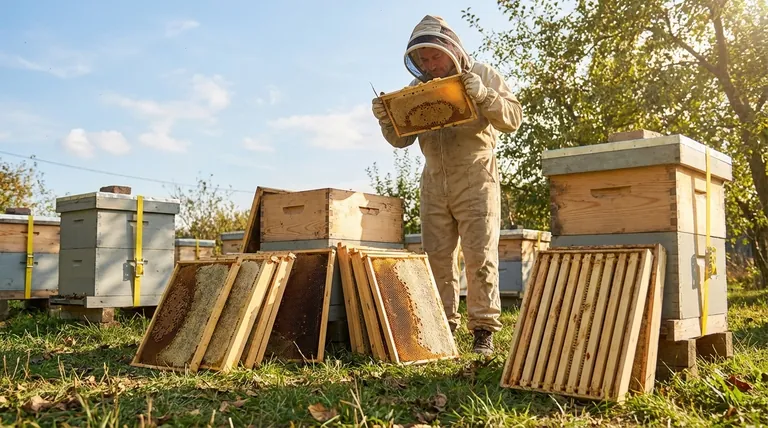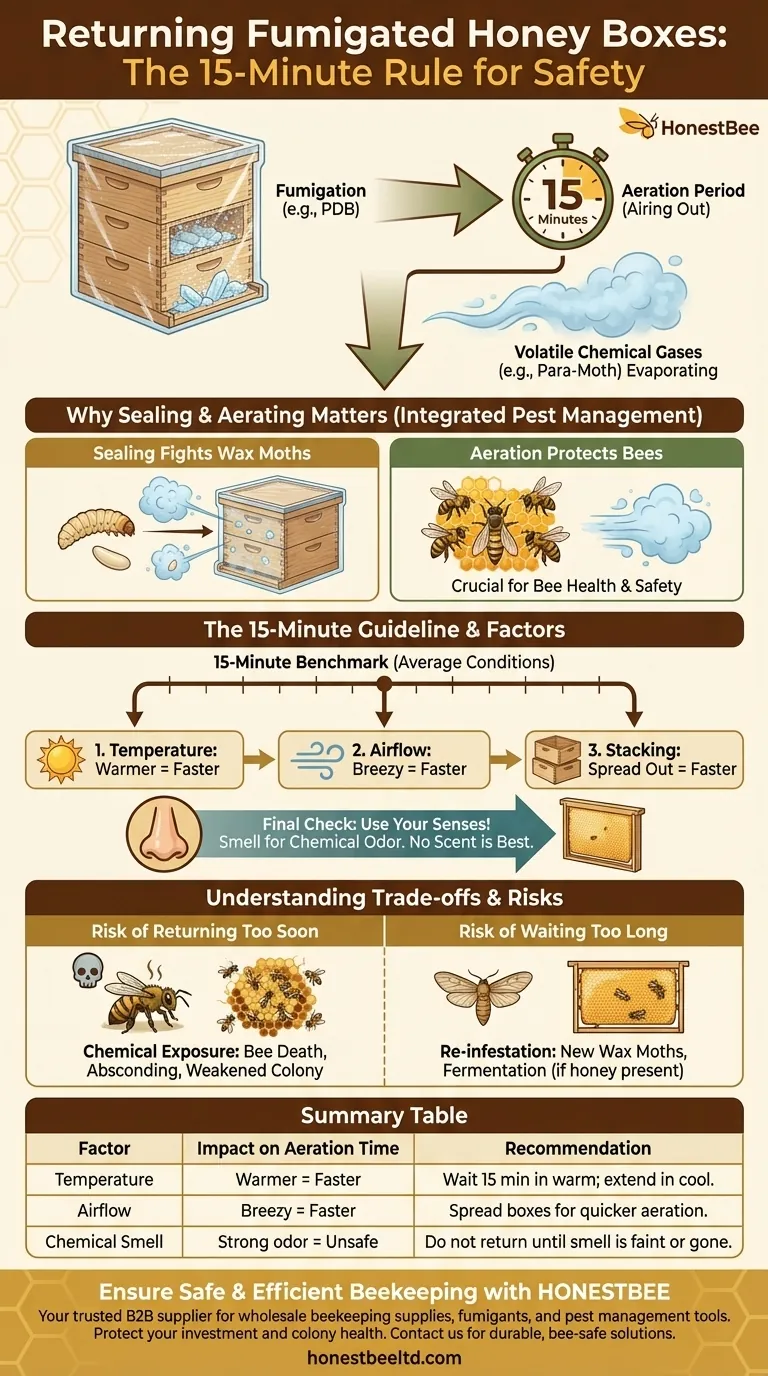In most cases, you can safely return honey boxes to the hive approximately 15 minutes after you remove the seals and begin to air them out. This short period is typically sufficient for the residual fumigant, used to control pests like wax moths, to evaporate竞争 and render the combs safe for your bees.
The 15-minute guideline is not an arbitrary rule; it is the minimum time needed for a volatile pest control chemical to aerate from the combs. The ultimate goal is to ensure no harmful residue remains, protecting your colony from chemical exposure.

The Purpose of Sealing and Aerating
Understanding why you seal honey boxes инфекция is the key to understanding why the aeration step is so critical. This process is a standard part of integrated pest management for stored beekeeping equipment.
Why Boxes are Sealed
Beekeepers typically seal stacks of honey supers (the "honey boxes") to fumigate them. This process is designed to kill pests, most notably the larvae and eggs of the wax moth.
The airtight seal ensures the fumigant's gas concentrates inside the stack, effectively eliminating all stages of the pest's life cycle.
The Role of Common Fumigants
The most common fumigant used for this purpose is paradichlorobenzene (PDB), often sold under brand names like Para-Moth.
While highly effective against wax moths, these chemicals are also toxic to honey bees. Returning combs with active residue can lead to bee death, absconding, or a weakened colony.
The Critical Aeration Step
Aeration is the process of "airing out" the combs after unsealing them. PDB and similar fumigants are volatile, meaning they readily turn from a solid crystal into a gas that dissipates in the air.
The 15-minute period allows these chemical gases to blow away, leaving the combs safe and clean for the bees to use.
Understanding the 15-Minute Guideline
While 15 minutes is a reliable benchmark, it is based on average conditions. True safety comes from confirming the fumigant has fully dissipated.
Factors That Influence Aeration Time
The speed of aeration is not constant. It can be influenced by:
- Temperature: Warmer air causes the fumigant to evaporate faster.
- Airflow: A breezy day will clear the boxes much faster than a still day.
- Stacking: Spreading boxes out individually provides more surface area for air to circulate, speeding up the process compared to leaving them in a stack.
Using Your Senses as a Final Check
The most reliable tool you have is your nose. PDB has a distinct, strong "mothball" smell.
Before returning the boxes, hold a frame up and smell it. If you can still detect a strong chemical odor, you should wait longer. A faint, barely-there scent is usually acceptable, but no scent is best.
Understanding the Trade-offs and Risks
Balancing speed and safety is crucial when handling treated equipment. Both rushing and waiting too long carry potential consequences.
The Risk of Returning Boxes Too Soon
This is the most significant risk. Introducing combs with active fumigant residue can weaken or kill your colony. The bees may refuse to work the frames, the queen may stop laying, or the entire colony could be poisoned.
The Risk of Waiting Too Long
Once the fumigant has dissipated, the combs are no longer protected. If left exposed for hours or days, they are once again a prime target for a new wax moth infestation.
Furthermore, if the supers contain residual honey, leaving them open to the air for extended periods can cause the honey to absorb moisture, increasing the risk of fermentation.
How to Apply This to Your Hive
Your primary goal is to return clean, pest-free combs without harming your bees. Use the 15-minute rule as a starting point and adjust based on your specific conditions.
- If your primary focus is safety in warm, breezy weather: The 15-minute aeration time is likely sufficient, but always confirm by smelling the combs for any residual chemical odor.
- If your primary focus is caution in cool, still conditions: Extend the aeration period to 30 minutes or more, and do not return the boxes until they are free of any noticeable chemical scent.
- If your primary focus is efficiency with many supers: Unstack the boxes and spread them out to maximize airflow, which ensures a more rapid and thorough aeration for all your equipment.
Ultimately, your judgment is the final and most important safeguard for the health of your hive.
Summary Table:
| Factor | Impact on Aeration Time | Recommendation |
|---|---|---|
| Temperature | Warmer = Faster | Wait 15 min in warm weather; extend in cool conditions. |
| Airflow | Breezy = Faster | Spread boxes out on windy days for quicker aeration. |
| Chemical Smell | Strong odor = Unsafe | Do not return boxes until smell is faint or gone. |
Ensure your beekeeping equipment is safe and efficient with HONESTBEE. As a trusted supplier of wholesale beekeeping supplies and equipment for commercial apiaries and distributors, we provide high-quality fumigants, honey supers, and pest management tools to protect your investment. Don't risk your colony's health—contact us today to get durable, bee-safe solutions tailored to your operation!
Visual Guide

Related Products
- Professional Galvanized Hive Strap with Secure Locking Buckle for Beekeeping
- Versatile Ratchet Hive Strap with S-Hooks for Secure Fastening
- Langstroth Screen Bottom Board for Beekeeping Wholesale
- Lightweight Durable Plastic Queen Excluder Scraper for Beekeeping
- Professional Wide Blade Honey Scraper for Beekeeping and Honey Processing
People Also Ask
- What are hive straps and why are they used? Secure Your Hives Against Wind, Predators, and Transport
- Why are hive straps important for beekeepers? Secure Your Hives Against Wind, Predators & Transport
- How can beekeepers secure the top cover of a hive? Protect Your Colony from Wind and Weather
- Can straps with hook ends be used for beehives? A Guide to Secure Hive Management
- What are the types of Emlocks available? Choose the Right Strap for Hive Security



















